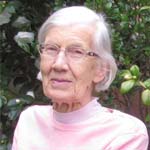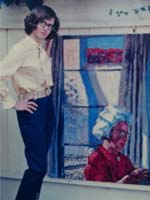
Vija B. Lusebrink, 97, celebrated art therapist, professor, author, artist, colleague, and mentor passed away on June 12. Her passing is sorrowful for countless art therapists across the US and abroad. Her impact on the world of art therapy is expansive and profound. It is amazing that a person who dealt with so many challenges as a young adult evolved into a master art therapist, professor, and author.
Her journey from war torn Latvia to the United States was harrowing both during and in the aftermath of WWII. Yet she, along with her mother and sister, made it to the US. During the early years of her life in the US, Vija received a BS in chemistry, an MFA in painting, and raised three daughters.
Vija found art to be vital to her life. Living in California offered her numerous opportunities for involvement in arts, healing, and human potential workshops, which included learning from noted thinker John W. Perry and renowned art therapist Janie Rhyne. What evolved from these encounters was a passion for learning about and conducting art therapy, which led her to take a position at a hospital for those suffering from mental illnesses.
At the hospital, she realized that she had a desire to teach others what she learned from conducting art therapy with the patients. In 1974 she applied for and received a position at the Institute for Expressive Therapies (IET) housed at the University of Louisville in Kentucky. She taught there until her retirement in 1995, which included nine years as its director (1986-1995). She was proud to have taught over 400 students through two decades at UofL.
While at UofL, she completed a doctorate degree where she explored her theories on various levels of artistic expression. These studies included the seeds of the Expressive Therapies Continuum (ETC), which she refined with her colleague, Sandra (Kagin) Graves. Together they published a 1978 article on the topic in the Arts in Psychotherapy. In her book, Imagery and Visual Expressive in Art Therapy (1990), Vija delved more deeply into the theory of the ETC. This framework was a major advancement in the field of art therapy as it is one of the first theoretical perspectives that was rooted in the theory and practice of art therapy.

The ETC is now taught in numerous graduate art therapy programs here and around the world. Vija developed and maintained strong ties to art therapists in Latvia through advising research projects, co-writing papers, and teaching. In April of 2018, she gave a final lecture to the art therapy department at the University of Riga, the city where she was born.
In addition to the ETC, Vija had three other areas of inquiry that fed her intellectual curiosity: levels of expression across the arts therapies, the importance of symbols in cross-cultural studies of art therapy, and imagery as healing.
In understanding imagery and its link to healing, Vija subscribed to the use of visual journals. For students, she called these ‘doodle diaries’ because she did not want students to think too hard about the journal entries and wanted the entries to be spontaneous. She theorized that these images, over time, would open the unconscious world of the individual. She encouraged the use of dream journals as well. In her own experience journaling her dreams and then drawing them, led her to realize she might have cancer, a carcinoma, on her back. Without the use of the dream and doodle journal, she may not have sought treatment for this lethal disease.
Recently, Vija studied advances in neuroscience and how these advances underscore the significance of the ETC. She authored several articles on this subject. It is unbelievable that she recently penned a final article on the ETC during her 96th year.
Vija worked tirelessly for American Art Therapy Association (AATA) through three committees: Education, Standards, and Research. She also was instrumental in the formation of the Kentucky Art Therapy Association (KYATA)and often offered lectures and workshops for this group. Upon her retirement from UofL, KYATA honored her with bestowing a research award in her name for deserving students.
For her significant contributions to the field of art therapy, AATA awarded Vija the Honorary Life Member (HLM), its highest honor, in 1995. There is little doubt that Vija made a major contribution to the field of art therapy. Her brilliance, her sensitivity, and her warm, lovely smile will be missed by many. She will not be forgotten any time soon.

Sandra Graves-Alcorn was a licensed professional art therapist and a retired Professor Emeritus from the University of Louisville, where she started the first Masters Degree in Art Therapy Program and developed the Institute of Expressive Therapies. She taught there for 30 years before retiring to practice in the private sector. During her tenure at the University, she was privileged to take several courses in law school that ended up contributing to her Interdisciplinary Ph.D. in Psychiatry, Pediatrics and Special Education. Her studies in trauma, oncology and high-risk neonatology lead her to a career in grief counseling and trauma-informed practice.
Graves was a founder of four companies in her career, one in aftercare services for funeral homes throughout the U.S., two counseling agencies and one foster care agency. She began her career as an Expert Witness approximately forty years ago by identifying factors in children's drawings indicative of trauma and abuse. She has been affiliated with high-profile cases such as the Standard Gravure murders, the Radcliff bus crash and the Shanda Shearer murder case, which led to an appearance on the Oprah Winfrey show. She evaluated serial rapists and murderers in death penalty cases as well as provided other forensic services across the country. Graves vast experience also lead her to become a regular guest expert on WAVE Country News, in which she talked about creative coping with daily life events as well as those involving trauma.
In her scholarly activities, Graves has lectured throughout the United States and Canada. She published and edited a journal on grief, has written numerous articles for professional journals and associations, and is one of the founders and past president of the American Art Therapy Association. She was a published book author, including Expressions of Healing and Implementing the Expressive Therapies Continuum. She also wrote chapters for other books, and her work with death row inmates was published in Art on Trial. She presented in several venues about the Art Therapist as an Expert Witness. Upon her retirement from the University of Louisville, Graves was awarded the distinction Outstanding Alumnae.
As part of community service, she was co-therapist for Survivors of Suicide and founded SAME (Surviving a Murder Effectively). She also helped develop RESPOND, a crisis team comprising a coalition of mental health agencies in Louisville and was on the Steering Committee and Coordinator of Training for Critical Incident Stress Debriefing teams in seven counties in Kentucky and southern Indiana. Appointed to the Governor's Task Force on Childhood Sex Abuse, she was invited to be co-chair of the Intervention Committee, Task Force on Childhood Sex Abuse appointed by the Commonwealth Attorney. She was also a member of Rotary, graduated from the Leadership Oldham County program, helped found and later served as president of the Oldham County Arts Association where she helped start Arts on the Green. She was also a Coordinator of Teen Court for Oldham County. Graves was currently serving on the Board of Expressive Media, Inc.
Graves was a member of the American Art Therapy Association and the International Society of Mental Health Forensic Science. She provided forensic evaluation, treatment and Expert Witness Testimony for Shelton Forensic Solutions. Graves was a loving mother, daughter, sister, wife and Nana/Bannie. She took care of her father Roy Graves until his death at age 97, helped support her children through addictions, spiritual journeys and hardships, divorces and family crises, and her grandchildren with their academics and mental health.
She was a woman who emanated joyfulness and love, which was personified by her boisterous laugh and contagious happiness. She was someone who you always wanted in your corner, and your audience, as she would revel in each joke, story or anecdote you had to tell her and would listen as though what you said had infinite value. She was uncompromising in her playfulness, always being herself and never anyone else. She encouraged everyone in her life to do the same. She was extravagant, sparkled inside and out, and could be found dancing in twinkling shoes and brilliant colors any day. She was someone who had great empathy, and knew what it meant to acknowledge pain and to give the grace needed to move past trauma. She was someone who was loved and reciprocated that love to the fullest of her ability. She was a marvel. She has left a dynamic legacy.